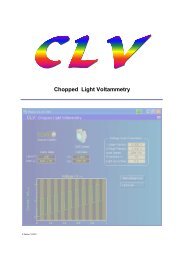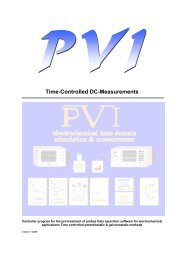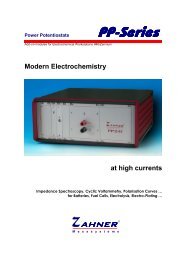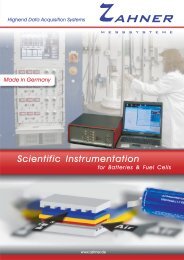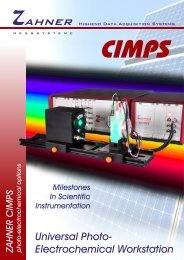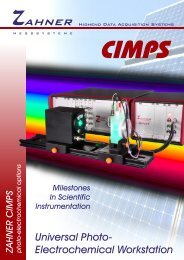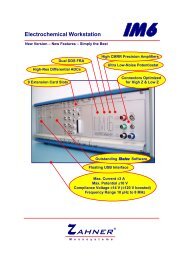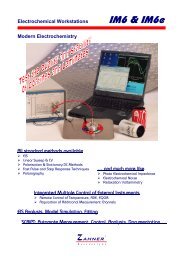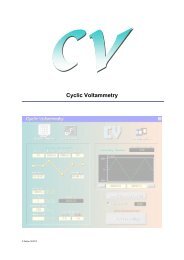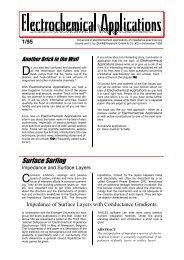CIMPS-abs.pdf
CIMPS-abs.pdf
CIMPS-abs.pdf
- No tags were found...
You also want an ePaper? Increase the reach of your titles
YUMPU automatically turns print PDFs into web optimized ePapers that Google loves.
<strong>CIMPS</strong>-<strong>abs</strong> -22-<br />
3.4. Spectrometer Settings<br />
Acquisition of light spectra is done with the controls on the right hand side of the <strong>CIMPS</strong>-<strong>abs</strong> main<br />
window. A click on the spectrometer icon opens the spectrometer settings of Fig. 29, which are valid<br />
for all following measurements.<br />
Fig. 29 Setup of the spectrometer<br />
The wavelength range can be set arbitrarily within the maximum range of the used spectrometer,<br />
which is 250 – 1000 nm for the ILT-9x0. As the ILT-9x0 is a CCD-array spectrometer the entered<br />
wavelength range has no influence on sensitivity, needed acquisition time or other parameters.<br />
Integration time determines the amount of light collected during a single spectrum and can be set<br />
between 1 ms and about 10 s. To reduce noise several spectra can be recorded and averaged<br />
automatically. Please mind the overall measurement time of integration time multiplied with the<br />
number of averages.<br />
3.5. Dark Reference Spectra<br />
Before the spectrometer can record spectra a dark scan has to be done. Therefore the buttons for<br />
bright reference, <strong>abs</strong>orbance and <strong>abs</strong>orbance series are disabled in <strong>abs</strong>ence of a dark scan. During<br />
the dark scan detector dark current, electronic noise and residual scattering light inside the<br />
spectrometer are measured and subtracted automatically from all following spectra. Each change of<br />
the integration time requires a new dark scan.<br />
When using LED light sources please ensure that ambient light is excluded during the dark scan. A<br />
enclosure covering the complete optical bench is recommended to avoid detrimental effects caused by<br />
ambient light during the whole measurement time. Due to the high light intensity of tungsten halogen<br />
light sources here a low level of ambient light is acceptable.<br />
Dark scans can be done manually using the Dark Reference button (Fig. 30). Presence of a valid dark<br />
scan is indicated by a checkmark on the right hand side of the Dark Reference button.<br />
Fig. 30 Manual acquisition of a dark reference spectrum<br />
During series measurements dark reference spectra can be recorded automatically before each<br />
<strong>abs</strong>orbance spectrum by setting the Auto Darkscan option. This is recommended as it eliminates the<br />
drift of the spectrometer dark signal.<br />
3.6. Bright Reference Spectra<br />
The bright reference can either be recorded from the reference cell or the measurement cell. With the<br />
Auto Light option activated (see Fig. 31) the <strong>CIMPS</strong> Actuator is automatically moved to the reference<br />
cell for bright reference spectra and back to the measurement cell for <strong>abs</strong>orbance spectra. Additionally<br />
the default state of the light source can be set. The light source is in the default state whenever no<br />
spectrum is recorded. Because of the high thermal burden of tungsten halogen lamps in this case the<br />
default state is locked to off.



